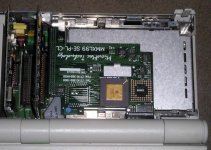Trash80toHP_Mini
NIGHT STALKER
Tilting at Luggable Windmills: Take 1
Portable Accelerator Card
 ] ]'>
] ]'>
Step two would appear to be electrical adaptation considerations for the design of a right angle/displacement adapter cards setup for the Luggable PDS Slot.
I wonder if the AztecMonster + MicroMac MMXL99 SE-PL-CL >< HD 40SC power budget? :?:
edit: that MicroMac 'O3O card fits very nicely in the HDD bay, BTW!
The empty thru-holes on the end could also be soldered directly to headers atop a single adapter card. }
Portable Accelerator Card
Since there is ZERO power budgeted in the Portable for any PDS device, it looks like removing the HDD and installing AztecMonter CF storage will be step one for harvesting a power budget allocation. Conveniently, this harvests a significant hunk of cubic contiguous with that allocated to the Portable's PDS. [Table 13-4 lists the MC68HC000 processor signals available at the Macintosh Portable 68000 Direct Slot expansion connector and describes their functions. Notice that most of the signals are the same as the Macintosh SE processor signals.
Step two would appear to be electrical adaptation considerations for the design of a right angle/displacement adapter cards setup for the Luggable PDS Slot.
I wonder if the AztecMonster + MicroMac MMXL99 SE-PL-CL >< HD 40SC power budget? :?:
edit: that MicroMac 'O3O card fits very nicely in the HDD bay, BTW!
The empty thru-holes on the end could also be soldered directly to headers atop a single adapter card. }

